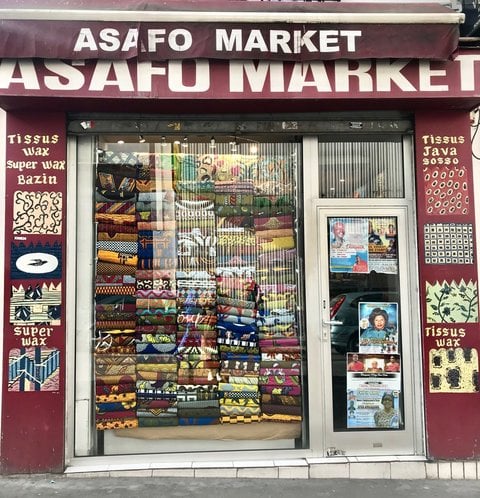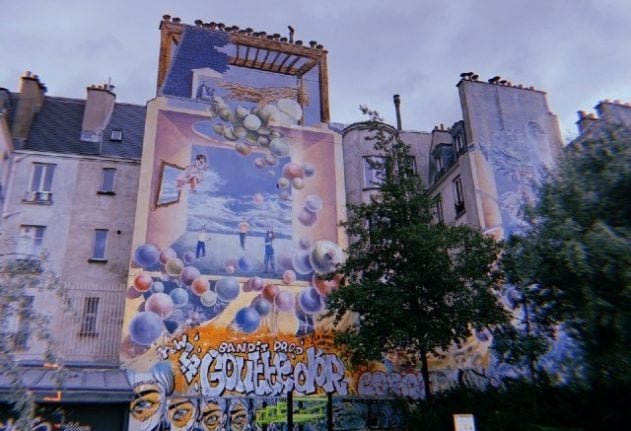“She made that for Beyoncé,” Jacqueline Ngo Mpii, 31, nodded towards her friend and designer, Dyenaa Diaw, who runs a clothing shop in Goutte d’Or ('drop of gold'), an African dominated neighbourhood in the northern part of Paris.
Tucked away in one of the area’s less bustling streets, Diaw’s shop was not easy to spot unless Jacqueline had pointed it out. Golden jewelry twinkled in the windows, reflecting the silhouettes of handmade dresses sewn with thick fabric and delicate patterns. Propped up on a table in the corner, pop-royalty Beyoncé looked out on the customers from a framed picture where she was wearing a pantsuit from the store.
Stroking the fabric of one of the dresses, Jacqueline said that the store illustrated the point she had tried to make earlier.
“People don’t see Goutte d’Or as a place of interest, but there is an amazing textile and tailoring industry here,” she said.
Since 2015, Jacqueline has shown tourists around Goutte d’Or with tours organised by her company Little Africa.
“Wherever you go in the world, people have stars in their eyes when they think about Paris. It’s a dream destination, like a fairytale,” she said.
“I wanted to show them something else.”

Jacqueline Ngo Mpii's mother moved from Cameroon to Paris when Jacqueline was little. When she was 10, she came to join her. Photo: Little Africa
Goutte d’Or is situated in the same arrondissement, the 18th, as the bustling tourist hub Montmartre. One street divides the two, and this is the street where Jacqueline begins her tour.
“It really illustrates the contrast of the two areas,” she said.
Montmartre is a classic example of what Jacqueline called “postcard Paris”, the romantic Paris shown in movies, of white table cloths, red wine and artistic heritage.
But a string of French authors and activists are pushing to challenge the cliché, calling for a broader definition of what “Paris” is – and the “Paris woman” – which they see as too narrow, too white, too monolithic to celebrate the richness and diversity of the country's culture.
'Romanticised and commodified' – why France is rejecting the 'Paris woman' cliché
@Yaquelinah founded the company to show that Paris is more than the “romantic postcard version everyone knows”.
Here she’s showing off Wax print, traditional clothing African sold in a string of shops in Goutte d’Or. pic.twitter.com/iTCF0LO4BR— Ingri Bergo (@ingribergo) August 26, 2020
Shops sell wax print cloth – a print originally exported from the Netherlands to the African coast, now Ghana, late in the 19th century – to make tailored skirts, dresses and jackets.
“It’s a vibrant, animated, crowded little village with an amazing textile industry, tailors and unique craftsmanship,” Jacqueline said.
“I want to show that France has had an African migrant population for many years. It’s not something that appeared yesterday,” she said.

Wax is a traditional African fabric worn in many countries on the continent. First imported to the Gold Cost from the Netherlands in the 1890s, but since then African populations have made the print their own. Photo: Little Africa
Born in Cameroon, Jacqueline came to France when she was 10 and developed a close relationship to Goutte d'Or when she moved to Paris.
She knew the neighbourhood and what it had to offer, but she also knew that other people did not see it the way she did. When she googled Goutte d’Or, the internet version was a reduced and distorted version of her own.
For a long time, Goutte d'Or was not recognised as a part of Paris, even though it was just around the corner of some of the most iconic Parisian symbols and monuments.
“No one talks about Goutte d'Or. It’s a hidden treasure,” she said.
When they do talk about it, the things said are often negative. In 2015, after the Paris terror attacks, Fox news labelled the area a “no-go zone” in a broadcast. The characterisation was widely ridiculed by French media.
In Goutte d'Or a fashion designer made fun of the characterisation by making T-shirts with “Barbès go zone”, with reference to a part of the neighbourhood.
Still, it struck a chord in that Goutte d’Or’s historic relationship with Paris is a troubled one, and even inside Paris the area has long been branded a den of crime, prostitution and drugs.
Most of her customers are Americans, so Jacqueline – in case they saw the Fox news report – typically begins her tour by reassuring the participants that the area is safe.
“Tourists sometimes tell me that their Uber or Taxi driver asked them ‘why are you going there?’ It’s so dangerous, you will be robbed’,” Jacqueline said.
“It’s funny, because when they arrive they say ‘oh, I’m from New York, this is very familiar to me,’ or ‘I feel like I’m back home in Chicago’.”
While this kind of reaction could seem puzzling – why would American tourists feel less awkward in Goutte d’Or than someone from Paris? – highlights what Jacqueline called the French “ambivalence” towards its immigrants and African heritage.
“In the US, people from the banlieues are proud of coming from there. They know that these places produces culture, art and music.
Banlieue is French for 'suburb', but in France the term is associated with areas that are more deprived than the city they enclose.
“In France, people are ashamed. They will say say 'well, I'm not really from there',” she said.
Her hope is that, by pushing for a wider reckoning of the positive influence of the country's African immigrants on the capital, she with time can convince more of the some 12 million tourists who come every year to climb Montmartre's Sacré Cœur Basilica to cross the street into Goutte d’Or.



 Please whitelist us to continue reading.
Please whitelist us to continue reading.
Member comments